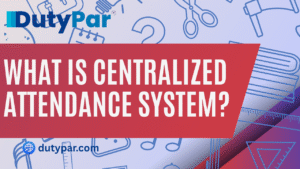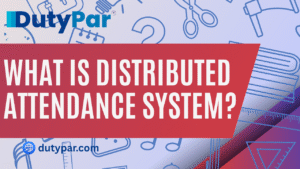Implementing an attendance tracking system can improve efficiency, but avoiding common mistakes—such as failing to define policies, using manual systems, or neglecting employee training—is crucial for success. The DutyPar Attendance App offers a streamlined solution to overcome these challenges and ensure compliance.
Table of Contents
Introduction
Are you considering implementing an attendance data tracking system for your organization?
Managing employee attendance is a critical aspect of business operations that can impact productivity, profitability, and compliance. However, implementing an attendance tracking can be challenging if you don’t know what to do. In this article, we’ll discuss common mistakes to avoid when implementing an attendance tracking and how DutyPar Attendance App can help you streamline attendance management.
Mistake #1: Failing to Define Attendance Policies
One of the most common mistakes organizations make when implementing an attendance tracking is failing to define attendance policies.
Attendance policies outline rules and regulations regarding employee attendance, such as when employees should arrive, how many hours they should work, and what happens if they’re late or absent.
Without clear attendance policies, your attendance data tracking system may not be effective, and you may face compliance issues.
Solution: Define Attendance Policies
Before implementing an attendanc data tracking system, it’s essential to define attendance policies that align with your business goals and comply with labor laws.
Your attendance policies should cover the following:
- Employee attendance expectations
- Overtime rules
- Absence reporting procedures
- Punctuality requirements
- Leave management
By defining attendance policies, you’ll ensure that your attendance data tracking system is aligned with your business goals and compliant with labor laws.
#2: Using Manual Attendance tracking system
Another common mistake organizations make is using manual attendance tracking.
Manual attendance data tracking is time-consuming, error-prone, and can result in inaccurate data.
Additionally, manual attendance tracking can be difficult to scale, especially if your organization has multiple locations.
Solution: Use an Attendance Tracking System
To avoid the pitfalls of manual attendance data tracking, consider using an attendance data tracking system.
An attendance tracking is a software solution that allows you to automate the attendance data tracking process. With an attendance tracking, you can:
- Track employee attendance in real-time
- Generate attendance reports
- Monitor employee absence and tardiness
- Streamline leave management
- Eliminate data entry errors
DutyPar Attendance App is an excellent attendance tracking that can help you streamline attendance management. DutyPar Attendance App is easy to use, customizable, and can be accessed from any device.
#3: Not Training Employees
Another common mistake organizations make is not training employees on how to use the attendance data tracking system.
Without proper training, employees may not understand how to use the system, leading to errors and frustration.
Solution: Train Employees
To ensure that your attendance data tracking system is effective, it’s essential to train employees on how to use the system.
Your training program should cover the following:
- How to log in and log out of the system
- How to request time off
- How to report absences
- How to view attendance records
- How to use the mobile app (if applicable)
By training employees, you’ll ensure that everyone is on the same page and using the attendance data tracking system correctly.
#4: Not Addressing Privacy Concerns
Privacy concerns are a significant issue when it comes to attendance data tracking systems.
Employees may be uncomfortable with the idea of their attendance being tracked, and they may have questions about how their data is being used.
Solution: Address Privacy Concerns
To avoid privacy concerns, it’s essential to address them proactively. You should explain to employees why the tracking system is being implemented, how their data will be used, and what measures are in place to protect their privacy.
Additionally, you should comply with labor laws regarding data privacy.
#5: Not Reviewing Attendance tracking Records Regularly
Another common mistake organizations make is not reviewing attendance records regularly.
Reviewing attendance records regularly is essential for identifying attendance trends, addressing attendance issues, and ensuring compliance.
Solution: Review Attendance Records Regularly
To ensure that your attendance data tracking system is effective, it’s essential to review attendance records regularly. You should review attendance records on a daily, weekly, or monthly basis, depending on your business needs. By reviewing attendance records regularly, you’ll be able to identify attendance trends, address attendance issues, and ensure compliance.
#6: Not Integrating with Other Systems
Finally, another common mistake organizations make is not integrating their attendance data tracking system with other systems, such as payroll and time-off management systems.
Without integration, data entry errors can occur, and the attendance tracking may not be as effective.
Solution: Integrate with Other Systems
To avoid the pitfalls of not integrating your attendance data tracking system with other systems, consider integrating your attendance data tracking system with other systems, such as payroll and time-off management systems.
Integration will ensure that data is accurate and up-to-date, and you’ll be able to streamline attendance management.
Conclusion
Implementing an attendance tracking system can be challenging, but by avoiding common mistakes, you can ensure that your attendance data tracking system is effective, efficient, and compliant. Remember to define attendance policies, use an attendance data tracking system, train employees, address privacy concerns, review attendance records regularly, and integrate with other systems.
By doing so, you’ll be able to streamline attendance management and focus on your business goals. Consider using DutyPar Attendance App to help you streamline attendance management and avoid the pitfalls of manual attendance data tracking.





